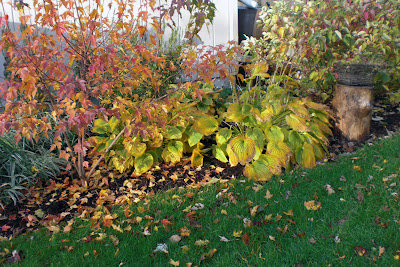When we moved to our home in October of 2007, our lot contained ZERO trees! I can't
believe I chose to move into a place without
any trees. Since then, of course, I have planted several trees. Most of them are smaller in stature because our lot is not very large. But I am determined for this lot to host as many trees as possible and have added some pivotal large trees including a White Pine and a Pin Oak,
Quercus Palustris, named for its many short side twigs or pinlike spurs. (It is this dense branch structure that makes an ideal shelter for wildlife.) Palustris is latin for "swampy" or "marshy" indicative of the conditions in which Pin Oaks are likely to grow.
According to Douglas Tallamy, Oaks support 517 species. He states in his book
Bringing Nature Home, "The value of oaks for supporting both vertebrate and invertebrate wildlife cannot be overstated ... What we have underappreciated in the past, however, is the diversity of insect herbivores that Oaks add to forest ecosystems. From this perspective, Oaks are the quintessential wildlife plants: no other plant genus supports more species of Lepidoptera, thus providing more types of bird food, than the mighty Oak ... A careful inspection of Oak leaves, particularly their undersides, often turns up caterpillars unlike any you have seen before."
This is why I chose to plant an Oak in my garden.
Pin Oaks are readily available in the nursery trade because they transplant well. They are naturally wetland trees with shallow, fibrous root systems,
unlike other Oaks, which have strong, deep taproots. My backyard does tend to become a bit "swampy" in the Spring and after heavy rains. They are also pyramidal in shape – less sprawling than other varieties of Oak. A shape that better suits the size of my lot. When mature, the upper branches point upwards, the middle branches are perpendicular to trunk, and the lower branches angle down. Pin Oaks grow somewhat faster than other Oak varieties. I planted my twig of a Pin Oak in the fall of 2008. This is my Pin Oak last fall of 2010.
This is my Pin Oak now. This is the year it has leaped! It has not fully turned yet.
Its leaves eventually become a beautiful dark red in autumn and are the last to fall, if at all. Pin Oaks are known to retain their leaves through winter.
I will be sure to check the undersides for caterpillars next summer! Some interesting trivial facts about Pin Oaks are that black ink can be made from galls formed by insects, and Native Americans used its bark to treat intestinal ailments. Huh.
Its acorns are round but flatten at the cap, which is thin and saucer-like. I look forward to the day these acorns drop in my garden. The jays, grey squirrels, and new resident red squirrel are sure to appreciate them, too.
 |
| Pin Oak in nearby Grass Point State Park |
The Pin Oak will attract songbirds, ground birds, water birds, hummingbirds, and mammals. It is the only known food source of the
Bucculatrix domicola caterpillar, a kind of leaf miner that transforms into a very small moth. It is also the host plant for the Gray Hairstreak,
Strymon melinus.
Sources: Bringing Nature Home by Douglas W. Tallamy, Wikipedia, Lady Bird Johnson Wildflower Center


























































